George Monck, 1st Duke of Albemarle
Last updatedGeorge Monck,1st Duke of Albemarle [lower-alpha 1] KG PC JP (6 December 1608 –3 January 1670) was an English soldier,who fought on both sides during the Wars of the Three Kingdoms. A prominent military figure under the Commonwealth,his support was crucial to the Restoration of Charles II in 1660,who rewarded him with the title Duke of Albemarle and other senior positions.
Contents
- Personal details
- Early career,pre-1641
- Ireland and England,1641–1646
- The Interregnum
- The Restoration
- Later career and death
- Notes
- References
- Sources
- Bibliography
The younger son of an impoverished Devon landowner,Monck began his military career in 1625 and served in the Eighty Years' War until 1638,when he returned to England. Posted to Ireland as part of the army sent to suppress the Irish Rebellion of 1641,he quickly gained a reputation for efficiency and ruthlessness. After Charles I agreed to a truce with the Catholic Confederacy in September 1643,he was captured fighting for the Royalists at Nantwich in January 1644 and remained a prisoner for the next two years.
Released in 1647,he was named Parliamentarian commander in Eastern Ulster,fought in Scotland under Oliver Cromwell in the 1650 to 1652 Anglo-Scottish War,and served as General at sea during the 1652 to 1654 First Anglo-Dutch War. From 1655 to 1660,he was army commander in Scotland,and his support for moderates in Parliament who wanted to restore the monarchy proved decisive in Charles II regaining his throne in May 1660.
Due to a combination of illness and lack of interest in politics,Monck faded into the background after 1660,but he returned to sea during the Second Anglo-Dutch War and played an important leadership role during the 1665 Great Plague of London,as well as the Great Fire of London in 1666. He lived in retirement for the last three years of his life and died in January 1670.
Personal details

Monck was born 6 December 1608 on the family estate of Potheridge in Devon,second son of Sir Thomas Monck (1570–1627) and Elizabeth Smith,daughter of Sir George Smith,three times Mayor of Exeter and reputed to be the richest man in Exeter. [1] His siblings included an elder brother Thomas (died 1647) and a younger,Nicholas Monck (1609–1661),later Bishop of Hereford and Provost of Eton College. [2]
One of the oldest families in Devon,the Moncks were relatively poor while Smith allegedly failed to pay the dowry promised for his daughter,leading to a series of expensive legal disputes with his son-in-law. [3] In 1625,Sir Thomas was imprisoned for debt and died in jail two years later. [4]
In January 1653,Monck married Anne Clarges (1619–1670),daughter of a London farrier and widow of Thomas Radford;his death was not legally confirmed until a year after their marriage,a fact which was later used against her. [5] Her brother Thomas (1618–1695) was a committed Royalist who was knighted after the Stuart Restoration and had a long career in Parliament. [6] They had one son who survived into adulthood,Christopher Monck,2nd Duke of Albemarle (1653–1688). [7]
Early career,pre-1641
Monck became a professional soldier,a common career choice for younger sons of impoverished gentry. His first experience was the failed attack on Cádiz in November 1625,when he served as an ensign in a company commanded by his cousin Sir Richard Grenville. He later joined the equally disastrous expedition against St Martin-de-Ré in July 1627;it is suggested one reason for doing so was his arrest for attempted murder in late 1626,when he and his brother Thomas assaulted Nicholas Battyn,the undersheriff responsible for jailing their father. [3]
He spent most of the next decade serving in the Dutch States Army,then considered the best place to learn the 'art of war' due to its success in the Eighty Years' War against Spain. Many officers who later fought on both sides during the Wars of the Three Kingdoms did the same,among them Sir Thomas Fairfax and Sir Philip Skippon. [8] During the capture of Maastricht in 1632,he served in a regiment commanded by the Earl of Oxford,who was killed in the final assault and replaced by George Goring. By 1637,Monck was lieutenant colonel under Goring and played a decisive role in storming Breda,a Dutch success which was one of the last major actions of the war. After quarrelling with the civil authorities of Dordrecht,he surrendered his commission and returned to England in 1638. [7]
During the 1639 and 1640 Bishops' Wars,he was lieutenant colonel in a regiment raised by Mountjoy Blount,1st Earl of Newport,who was also Master-General of the Ordnance. Monck was one of the few to emerge with any credit from the Battle of Newburn in 1640,when he saved the English artillery from capture. Lack of money meant the army was dissolved. Monck spent the next year unemployed. [7]
Ireland and England,1641–1646

Following the Irish Rebellion of 1641,Parliament approved the recruitment of a Royal Army to suppress it. Monck was made colonel of a regiment raised by his distant relative Robert Sidney,2nd Earl of Leicester,which landed in Dublin in January 1642 and served under the Earl of Ormond. [7] Over the next eighteen months,he campaigned against rebel strongholds in Leinster,during which he was responsible for several alleged massacres in County Kildare and also took part in the March 1643 Battle of New Ross. [9] However,the outbreak of the First English Civil War in August 1642 meant Ormonde could no longer receive reinforcements or money from England,and by mid-1643,the Catholic Confederacy controlled most of Ireland,with the exception of Ulster,Dublin and Cork City. [10]
Most of Ormond's officers,including Monck,argued the Irish Army should remain neutral between Parliamentarians and Royalists but Charles was anxious to use these troops to help him win the war in England and in September 1643,Ormonde agreed a truce or "Cessation" with the Confederacy. Factions on both sides objected to the terms,which included negotiations on freedom of worship for Catholics and constitutional reforms. Protestants saw this as a threat,while many Confederates felt they were on the verge of victory and gained nothing from the truce;they were also well aware any concessions Charles made to Catholics in Ireland undermined his position in England and Scotland. [11]
Monck was among those who refused to swear allegiance to the king and was sent by Ormonde as a prisoner to Bristol,where he eventually agreed to support the Royalists before being captured at Nantwich in January 1644. Although prisoners were commonly exchanged,his experience and ability were so highly regarded that he remained in custody for the next two years,during which he wrote a military manual entitled Observations on Military and Political Affairs. Following Charles' surrender in May 1646,he accepted an appointment in one of the regiments sent to Ireland by Parliament as reinforcements;in September 1647,he was appointed Parliamentarian commander in Eastern Ulster. [7]
The Interregnum

Monck proved his loyalty to Parliament by refusing to take part in the Second English Civil War and requiring all his officers to sign a declaration of support. However,his position in Ulster became extremely precarious following the execution of Charles I in January 1649,since it was dominated by Scots Presbyterian settlers,supported by a Covenanter army under Robert Monro. [12] The Scots did not only object to the English killing their king without consultation. As Calvinists,they viewed monarchy as divinely ordained,making the execution sacrilegious. [13] As a result,they defected to the Royalist–Confederate alliance led by Ormond and in desperation,Monck agreed to a secret truce with Eoghan ÓNéill,the Catholic leader in Ulster,which he did not communicate to Parliament until May. [9]
Recalled to London,he was reprimanded by a Parliamentary committee,although they privately recognised the desperate circumstances which made it necessary. Although some mistrusted Monck as a former Royalist,Oliver Cromwell gave him command of a regiment in the 1650 to 1651 Anglo-Scottish War,which fought at Dunbar,then stormed Dundee,an action in which 800 civilians were allegedly killed. [14] Throughout the Protectorate,Monck remained loyal to Cromwell,who appointed him military commander in Scotland until February 1652. At that time,Monck became seriously ill and retired to Bath in order to recover. Due to his expertise in utilising artillery,when the First Anglo-Dutch War began in November,Monck was made a General at Sea,along with Robert Blake and Richard Deane. He fought in the 1653 naval battles of Portland,the Gabbard and Scheveningen. [7]
In April 1653,Cromwell dissolved the Rump Parliament and in June Monck was nominated MP for Devon in Barebone's Parliament. [15] Although the Dutch war did not formally end until the February 1654 Treaty of Westminster,Monck was recalled and sent to Scotland to suppress the Royalist Glencairn's rising. Appointed military commander,he employed the ruthless tactics demonstrated in his previous assignments and by the end of 1655 the country had been pacified. He retained this position for the next five years,demonstrating his loyalty by removing any officers who expressed opposition to government policy and arresting religious dissidents. [7]
The Restoration
When Oliver Cromwell died in September 1658,Monck transferred his support to his son Richard,who was appointed Lord Protector. The Third Protectorate Parliament elected in January 1659 was dominated by moderate Presbyterians like Monck and Royalist sympathisers,whose main objective was to reduce the power and expense of the military. In April,army radicals led by John Lambert and Charles Fleetwood dissolved Parliament and forced the resignation of Richard Cromwell. Sometimes known as the Wallingford House party,the new regime abolished the Protectorate,reseated the Rump Parliament dismissed by Cromwell in 1653 and began removing officers and officials of suspect loyalty,including many of those serving in Scotland. [16]
Monck was left in place largely because rumours of another Royalist rising made it preferable to retain him. Both his cousin John Grenville and brother Nicholas were connected with the Royalist underground and in July 1659,Nicholas brought him a personal appeal from Charles II,asking for his help and offering up to £100,000 per year for his assistance. [17] When Booth's Uprising broke out in August 1659,Monck considered joining it but the revolt collapsed before he had time to commit himself. In October,the Wallingford House group dismissed the Rump before being forced to reinstate it in early December. [18]

By the end of 1659,England appeared to be drifting into anarchy,with widespread demands for new elections and an end to military rule. Monck declared his support for the Rump against the Republican faction led by Lambert,while co-ordinating with Sir Theophilus Jones,a former colleague in Ireland who seized Dublin Castle in late December. [9] At the same time,he marched his army to the English border,supported by a force raised by former New Model Army commander Sir Thomas Fairfax. Outnumbered and unpaid,Lambert's troops melted away;on 2 February Monck entered London and in April elections were held for a Convention Parliament. [19]
While his backing was essential to the Restoration,modern historians question whether the policy was initiated by Monck as opposed to following majority opinion,which by now was overwhelmingly in favour of reinstating the monarchy. [20] Although elected MP for Devon,external observers noted he had little interest in politics while the lack of a regional power base in England and the proposed reduction of the army mitigated his future influence. [15]
Nevertheless,the Declaration of Breda issued by Charles on 4 April 1660 was largely based on Monck's recommendations. It promised a general pardon for actions committed during the civil wars and Interregnum,with the exception of the regicides,retention by the current owners of property purchased during the same period,religious toleration and payment of arrears to the army. [21] Based on these terms,Parliament resolved to proclaim Charles king and invited him to return to England;he left Holland on 24 May and entered London five days later. [22]
Later career and death


In July 1660,Monck was made Duke of Albemarle and appointed to the Privy Council;he also received the former Palace of Beaulieu,lands in Ireland and England worth £7,000 per year,an annual pension of £700 and various offices,including Lord Lieutenant of Devon. He also obtained significant positions for his dependents and connections;John Grenville became Earl of Bath,while Nicholas Monck was appointed Bishop of Hereford,his cousin William Morice Secretary of State for the Northern Department and his brother-in-law Thomas Commissary General of Musters. [23]
Although appointed Lord Deputy of Ireland,Monck fell seriously ill once again in August 1661 and was replaced by Ormond,being "compensated" with the additional office of Lord Lieutenant of Middlesex. Thereafter he avoided front-line politics and focused on maximising his personal wealth;his wife was notorious for selling offices,although this was a common practice and probably reflected resentment at her humble origins. In his diary,Samuel Pepys attacks her as a "homely,plain dowd" and "filthy woman";however,his views were coloured by the rivalry between Monck and his cousin Edward Montagu,1st Earl of Sandwich,for control of the Admiralty. [24]

In 1663,Monck was allocated lands in the Province of Carolina,now the modern US states of South and North Carolina,whose Albemarle Sound is named after him. [25] He was also made a shareholder in the Royal African Company,established to challenge Dutch control of the Atlantic slave trade and a major factor in the commercial tensions between the two countries that eventually led to the Second Anglo-Dutch War in 1665. The conflict was backed by Monck and other investors within the government,including George Carteret,Shaftesbury and Arlington. [26]
Command of the fleet was given to James,Duke of York,with Sandwich as his deputy and Monck took over his administrative duties at the Admiralty. He also gained a great deal of popularity for remaining in London throughout the 1665 Great Plague when most of the government fled to Oxford. [27] Monck and Prince Rupert shared command during the 1666 campaign;the Four Days' Battle in June was a Dutch victory,offset by English success at the St. James's Day Battle in July. In September he was recalled to help maintain order in the chaos created by the Great Fire of London. [7]
This was his last active command;the fleet had to be laid up due to lack of money,culminating in the humiliating raid on the Medway in June 1667 which ended the war. One of the few to escape censure by Parliament,Monck was appointed First Lord of the Treasury but he was now suffering from severe edema which limited his ability to attend meetings. [15] He died on 3 January 1670,followed three weeks later by his wife,and was buried in Westminster Abbey. [2] Some years later a monument,by William Kent and Peter Scheemakers,was erected in the Abbey in Monck's honour. [2]
Notes
- ↑ Also spelled Monk in older texts
Related Research Articles

The Commonwealth was the political structure during the period from 1649 to 1660 when England and Wales, later along with Ireland and Scotland, were governed as a republic after the end of the Second English Civil War and the trial and execution of Charles I. The republic's existence was declared through "An Act declaring England to be a Commonwealth", adopted by the Rump Parliament on 19 May 1649. Power in the early Commonwealth was vested primarily in the Parliament and a Council of State. During the period, fighting continued, particularly in Ireland and Scotland, between the parliamentary forces and those opposed to them, in the Cromwellian conquest of Ireland and the Anglo-Scottish war of 1650–1652.

The Protectorate, officially the Commonwealth of England, Scotland and Ireland, is the period from 16 December 1653 to 25 May 1659 during which England, Wales, Scotland, Ireland and associated territories were joined together in the Commonwealth of England, governed by a Lord Protector. It began when Barebone's Parliament was dismissed, and the Instrument of Government appointed Oliver Cromwell Lord Protector of the Commonwealth. Cromwell died in September 1658 and was succeeded by his son Richard Cromwell.

The New Model Army or New Modelled Army was a standing army formed in 1645 by the Parliamentarians during the First English Civil War, then disbanded after the Stuart Restoration in 1660. It differed from other armies employed in the 1639 to 1653 Wars of the Three Kingdoms in that members were liable for service anywhere in the country, rather than being limited to a single area or garrison. To establish a professional officer corps, the army's leaders were prohibited from having seats in either the House of Lords or House of Commons. This was to encourage their separation from the political or religious factions among the Parliamentarians.

Major-General William Goffe, probably born between 1613 and 1618, died c. 1679, was an English Parliamentarian soldier who served with the New Model Army during the Wars of the Three Kingdoms. A religious radical nicknamed “Praying William” by contemporaries, he approved the Execution of Charles I in January 1649, and later escaped prosecution as a regicide by fleeing to New England.
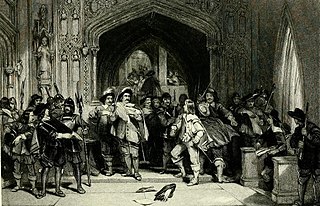
Colonel Thomas Pride was a Parliamentarian commander during the Wars of the Three Kingdoms, best known as one of the regicides of Charles I and as the instigator of Pride's Purge.

}} Sir Hardress Waller, c. 1604 to – 1666, was born in Kent and settled in Ireland during the 1630s. A first cousin of Parliamentarian general William Waller, he fought for Parliament in the Wars of the Three Kingdoms, becoming a leading member of the radical element within the New Model Army. In 1649, he signed the death warrant for the Execution of Charles I, and after the Stuart Restoration in 1660 was condemned to death as a regicide.

The Wars of the Three Kingdoms, sometimes known as the British Civil Wars, were a series of intertwined conflicts fought between 1639 and 1653 in the kingdoms of England, Scotland and Ireland, then separate entities united in a personal union under Charles I. They include the 1639 to 1640 Bishops' Wars, the First and Second English Civil Wars, the Irish Confederate Wars, the Cromwellian conquest of Ireland and the Anglo-Scottish war (1650–1652). They resulted in victory for the Parliamentarian army, the execution of Charles I, the abolition of monarchy, and founding of the Commonwealth of England, a unitary state which controlled the British Isles until the Stuart Restoration in 1660.
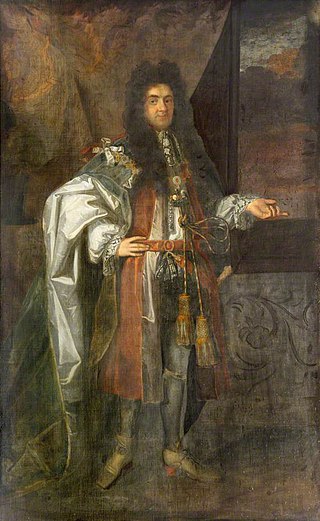
Christopher Monck, 2nd Duke of Albemarle was an English Army officer, peer, politician and colonial administrator who sat in the House of Commons from 1667 to 1670 when he inherited his father's dukedom and sat in the House of Lords.
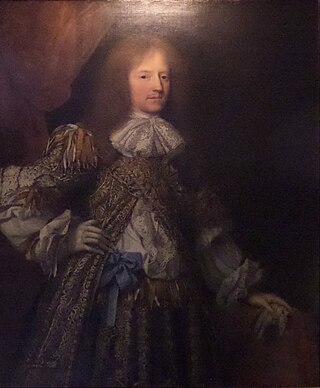
John Granville, 1st Earl of Bath PC was an English landowner who served in the Royalist army during the First English Civil War and was rewarded for his services after the 1660 Stuart Restoration with a title and various appointments.

Sir Michael Livesey, 1st Baronet, also spelt Livesay, was a Puritan activist and Member of Parliament who served in the Parliamentarian army during the Wars of the Three Kingdoms. He was one of the regicides who approved the Execution of Charles I in January 1649.

Sir William Lockhart of Lee (1621–1675), was a Scottish soldier and diplomat who fought for the Covenanters during the 1638 to 1651 Wars of the Three Kingdoms. Following Royalist defeat in the 1642 to 1647 First English Civil War, Lockhart took part in negotiations between Charles I and Scottish Engagers, who agreed to restore him to the English throne.

Nicholas Monck was a Bishop of Hereford and Provost of Eton College, both royal appointments made by King Charles II following the 1660 Restoration of the Monarchy which was largely effected by his elder brother George Monck, 1st Duke of Albemarle (1608–1670), KG. Nicholas Monck was "a great assistant in the Restoration to his brother".
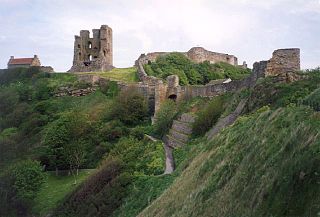
James Berry, died 9 May 1691, was a Clerk from the West Midlands who served with the Parliamentarian army in the Wars of the Three Kingdoms. Characterised by a contemporary and friend as "one of Cromwell's favourites", during the 1655 to 1657 Rule of the Major-Generals, he was administrator for Herefordshire, Worcestershire, Shropshire and Wales.

The Restoration of the monarchy began in 1660. The Commonwealth of England, Scotland and Ireland (1649–60) resulted from the Wars of the Three Kingdoms but collapsed in 1659. Politicians such as General Monck tried to ensure a peaceful transition of government from the "Commonwealth" republic back to monarchy. From 1 May 1660 the English, Scottish and Irish monarchies were all restored under King Charles II. The term Restoration may apply both to the actual event by which the monarchy was restored, and to the period immediately before and after the event.
Sir Thomas Clarges was an English politician who sat in the House of Commons at various times between 1656 and 1695. He played an important part in bringing about the Restoration of the Monarchy in 1660.

George Twisleton, 1618 to 12 May 1667, was a member of the landed gentry from Yorkshire and colonel in the Parliamentarian army during the Wars of the Three Kingdoms. Under the Commonwealth of England, he sat as MP for Anglesey from 1654 to 1659.

Thomas Birch, c. 5 June 1608 to 5 August 1678, was an English landowner, soldier and radical Puritan who fought for Parliament in the Wars of the Three Kingdoms, and sat in the House of Commons at various times between 1649 and 1658.

Sir Thomas Monck of Potheridge in the parish of Merton, Devon, was Member of Parliament for Camelford, Cornwall, in 1626. He was the father of George Monck, 1st Duke of Albemarle (1608–70), KG and of Nicholas Monck, Bishop of Hereford.

Potheridge is a former Domesday Book estate in the parish of Merton, in the historic hundred of Shebbear, 3 miles south-east of Great Torrington, Devon, England. It is the site of a former grand mansion house re-built by George Monck, 1st Duke of Albemarle (1608–1670) circa 1660 on the site of the former manor house occupied by his family since at the latest 1287. It was mostly demolished in 1734 after the death of the widow of his son Christopher Monck, 2nd Duke of Albemarle.
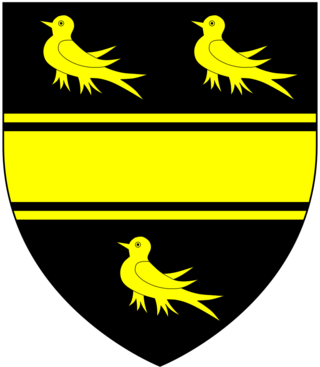
Sir George Smith of Madworthy-juxta-Exeter and Madford House, Exeter, Devon, was a merchant who served as MP for Exeter in 1604, was three times Mayor of Exeter and was Exeter's richest citizen, possessing 25 manors. He was the grandfather of George Monck, 1st Duke of Albemarle (1608-1670) KG and of John Grenville, 1st Earl of Bath (1628–1701).
References
- ↑ Yerby & Hunneyball 2010.
- 1 2 3 Westminster Abbey.
- 1 2 Stoyle 1993.
- ↑ Hunneyball 2010.
- ↑ Allen 1979, p. 100.
- ↑ Helms & Naylor 1983.
- 1 2 3 4 5 6 7 8 Hutton 2004.
- ↑ Dunthorne 2017, p. 176.
- 1 2 3 Clavin 2009.
- ↑ BCW.
- ↑ Royle 2006, pp. 211–212.
- ↑ Wedgwood 2001, pp. 82–83.
- ↑ Macleod 2009, pp. 5–19 passim.
- ↑ General George Monck’s Regiment.
- 1 2 3 Helms & Ferris 1983.
- ↑ Worden 2010, pp. 82–83.
- ↑ Jordan & Walsh 2012, p. 126.
- ↑ Hutton 1989, p. 127.
- ↑ Harris 2006, pp. 43–44.
- ↑ Hutton 1989, p. 128.
- ↑ Sharp 2000, p. 175.
- ↑ Hutton 1989, p. 131.
- ↑ Allen 1979, pp. 102–103.
- ↑ Allen 1979, pp. 100–101.
- ↑ McKenna, Amy. "Albemarle Sound inlet, North Carolina, United States". Britannica.com. Retrieved 15 December 2021.
- ↑ Sherman 1976, pp. 331–332.
- ↑ Allen 1979, p. 114.
Sources
- Allen, David (1979). "From George Monck to the Duke of Albemarle: His Contribution to Charles II's Government, 1660–1670". Biography. 2 (2): 95–124. doi:10.1353/bio.2010.0843. JSTOR 23539339. S2CID 159829412.
- BCW. "The Cessation of Arms". BCW Project. Retrieved 13 November 2020.
- Clavin, Terry (2009). Monck, George in Dictionary of Irish Biography.
- Dunthorne, Hugh (2017). From Revolt to Riches: Culture and History of the Low Countries, 1500–1700. UCL Press.
- General George Monck’s Regiment. "General George Monck's Regiment of Foot". BCW Project. Retrieved 28 May 2021.
- Harris, Tim (2006). Restoration; Charles II and his kingdoms. Penguin.
- Helms, MW; Naylor, Leonard (1983). Clarges, Thomas (c. 1618–95), of Westminster and Stoke Poges, Bucks. in 'The History of Parliament: the House of Commons 1660–1690'. Brewer & Boydell.
- Helms, MW; Ferris, John (1983). Monck, George (1608–70), of Potheridge, Merton, Devon in 'The History of Parliament: the House of Commons 1660–1690'. Brewer & Boydell.
- Hunneyball, Paul (2010). Monck, Sir Thomas (1570–1627), of Potheridge, nr. Merton, Devon in 'The History of Parliament: the House of Commons 1604–1629'. CUP.
- Hutton, Ronald (2004). "Monck, George, first duke of Albemarle (1608–1670)". Oxford Dictionary of National Biography (online ed.). Oxford University Press. doi:10.1093/ref:odnb/18939.(Subscription or UK public library membership required.)
- Hutton, Ronald (1989). Charles II: King of England, Scotland, and Ireland. Clarendon Press. ISBN 0198229119.
- Jordan, Don; Walsh, Michael (2012). The King's Revenge; Charles II and the Greatest Manhunt in British History. Little, Brown. ISBN 978-1408703281.
- Macleod, Donald (Autumn 2009). "The influence of Calvinism on politics" (PDF). Theology in Scotland. XVI (2).
- Royle, Trevor (2006) [2004]. Civil War: The Wars of the Three Kingdoms 1638–1660. Abacus. ISBN 978-0349115641.
- Scott, David (2003). Politics and War in the Three Stuart Kingdoms, 1637–49. Palgrave. ISBN 978-0333658741.
- Sharp, David (2000). England in Crisis, 1640–60. Heinemann. ISBN 978-0435327149.
- Sherman, Arnold A (1976). "Pressure from Leadenhall: The East India Company Lobby, 1660–1678". The Business History Review. 50 (3): 329–355. doi:10.2307/3112999. JSTOR 3112999. S2CID 154564220.
- Stoyle, Mark (1993). "The Honour of General Monck". History Today. 43 (8).
- Wedgwood, CV (2001) [1958]. The King's War, 1641–1647. Penguin Classics. ISBN 978-0141390727.
- Westminster Abbey. "George and Nicholas Monck". Westminster Abbey burials. Retrieved 25 May 2021.
- Worden, Blair (2010). "Oliver Cromwell and the Protectorate". Transactions of the Royal Historical Society. 20: 57–83. doi:10.1017/S0080440110000058. JSTOR 41432386. S2CID 159710210.
- Yerby, George; Hunneyball, Paul (2010). Smith, George (d. 1619), of Madford House, Exeter, Devon in 'The History of Parliament: the House of Commons 1604–1629'. CUP.
Bibliography
- Chisholm, Hugh, ed. (1911). . Encyclopædia Britannica . Vol. 18 (11th ed.). Cambridge University Press. pp. 723–724.
- Jamison, Ted R. George Monck and the Restoration: victor without bloodshed (Texas Christian University Press, 1975)
- Keeble, Neil H. The Restoration: England in the 1660s (2 vol., John Wiley & Sons, 2008)
